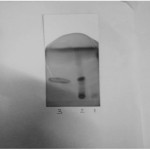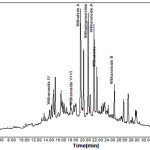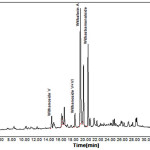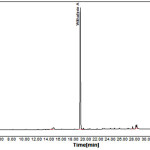Extraction and Isolation of Withaferin a ( Steroidal Lactone) from Withania Somnifera Leafs and it’s TLC and HPLC Analysis.
Dhananjay Dwivedi1, Bhorik Yadav2 and Neha Sengar3
1Department of Chemistry, P. M. B. Gujarati Science College, Indore.
2Gurjar Phytochem, Indore.
3Department of Chemistry, Umiya Girls College, Rau, Indore.
Corresponding Author E-mail: ddwivedi2009@gmail.com
DOI : http://dx.doi.org/10.13005/ojc/330360
Withania Somnifera (Ashwagandha) is one of the most important ancient medicinal plant of Unani and Ayurvedic system of traditional medicine which is extensively used by tribal people worldwide for many ailments. The leaves of the plant are bitter in taste and are applied for carbuncles, inflammation, swellings and conjunctivitis. In the present study phytochemical constituents present in withania somnifera leaf is studied by applying process of extraction and isolation and is analyzed by using TLC and HPLC method. The results show the presence of phytochemical ingredients like withanoside IV, withanoside V + VI, withaferin A, withastramonolide, withanolide A, withanone, withanolide B.
KEYWORDS:Withanolides; Withania somnifera; HPLC; Withaferin A
Download this article as:| Copy the following to cite this article: Dwivedi D, Yadav B, Sengar N. Extraction and Isolation of Withaferin a ( Steroidal Lactone) from Withania Somnifera Leafs and it’s TLC and HPLC Analysis. Orient J Chem 2017;33(3). |
| Copy the following to cite this URL: Dwivedi D, Yadav B, Sengar N. Extraction and Isolation of Withaferin a ( Steroidal Lactone) from Withania Somnifera Leafs and it’s TLC and HPLC Analysis. Orient J Chem 2017;33(3). Available from: http://www.orientjchem.org/?p=33333 |
Introduction
Withania Somnifera , commonly known as Ashwagandha belong to family Solanaceae and is one of the most important ancient medicinal plant of Unani and Ayurvedic system of traditional medicine.[1] The plant is mainly grows in drier parts of India and also cultivated for medicinal purpose. Withania Somnifera has wide range of bioactive compounds and extensively used by tribal people worldwide to cure many ailments. Traditionally , the plant is used to enhance energy, vigour, endurance, strength, health, vital fluids, muscle fat, blood, lymph, semen and cell production.[2] The plant is also useful in the treatment of burns, wounds, dermatological and gastrointestinal disorders, asthma, bronchitis, cancer and geriatric problems. It is called “ Indian Ginseng” for its great rejuvenating properties.[3] The leaves of the plants are applied for carbuncles, inflammation and swelling and its juice is useful in conjunctivitis.[4],[5]
Withanolids are steroidal compounds and mainly found in the leaves and roots of withania somnifera.[6],[7] The leaves of Withania Somnifera are reported to contain a number of withanolides and alkaloids.[8] Withaferin A is the most important withanolide which is found in the leaves and roots of the plant.
Experimental
Extraction and Isolation
200 gram leaf powder were extracted in 2 Liter round bottom flask with reflux condenser at 700 C by (80:20) methanol : water three times, first extraction is 800ml for 3hrs second is 600 ml for 3 hrs and third extraction is 600 ml 3hrs collected all extracted material in solvent in 5 liter round bottom flask with distillation setting, distilled out solvent at 600 C under reduced pressure to a volume of 40 ml and put it in a beaker kept overnight material were separated from liquid portion decant the liquid we get the material about 8 gram dry it under vacuum at 600C get 6 gram[9].
6 gram material from above refluxes in 50 ml pet ether 60-80 two times and decant the pet ether material is dry on silica for column chromatography 20 gram in air load on column with 25 gram silica gel for column chromatography eluted with Chloroform 150 ml first fraction CHCl3 : CH3OH (99:1) 300 ml second fraction , CHCl3:CH3OH (98.5: 1.5) Third fraction and check on TLC show withaferin A in the second and third fraction, Concentrated the second and third fraction under vacuum crystallized in methanol get 150 mg of 85 % purity.
Analytical: TLC System
Sample Preparation
150 mg standardized sample dissolve in 25 ml methanol and apply about 10 micro liter on TLC plate
100 mg sample before eluted column
2 to 3mg sample dissolve in 10 ml methanol and apply about 10 micro liter on TLC plate
Solvent system – Chloroform : Methanol (9.5:0.5)Detection – Spray Ethanol sulphuric acid reagent[10] black spot of withaferin A appeared
 |
Figure 1 Click here to View figure |
HPLC Analysis
Solution A: Dissolve 0.14 g of potassium dihydrogen phosphate in 900 mL of water, add 0.5 mL of phosphoric acid, dilute with water to 1000 mL, and mix.
Solution B: Filtered and degassed acetonitrile
Standard solution 1: Dissolve, using gentle heat, a quantity of standardized RS in methanol to obtain a solution having a known concentration of about 1.5 mg/mL.
Sample solution 2: Dissolve, using gentle heat, a quantity of in methanol to obtain a solution having a known concentration of about 6 mg/mL. ( before eluted on chromatographic column).
Sample solution 3: Transfer about 2 mg of isolated crystallized Powdered of withaferin weighed, to a 25-mL volumetric flask and make up with methanol to volume, and mix.
Before injection, all solution pass through a membrane filter having a 0.45-µm or finer porosity, discarding the first few mL of the filtrate[11].
Mobile phase: See the gradient table below.
|
Time |
Solution A |
Solution B |
|
0 |
95 |
5 |
|
18 |
55 |
45 |
|
25 |
20 |
80 |
|
28 |
20 |
80 |
|
30 |
95 |
5 |
|
40 |
95 |
5 |
Chromatographic system
Mode: LC
Detector: UV 227 nm
Column: 4.6-mm × 25-cm, end-capped; packing L1
Flow rate: 1.5 mL/min
Injection size: 20 µL
| Sample Name:1- | ASHWAGANDHA |
| Sample ID: | NRPL STANDARDIZED |
| Date: | 2016-10-17 PM 12:00:59 |
| Channel: | 1. YL9120 UVD A |
Chromatogram
 |
Figure 2 Click here to View figure |
Result
| No. | Name | RT[min] | Area[mV*s] | Height[mV] |
| 1 | Withanoside IV | 14.4167 | 77.8135 | 10.8373 |
| 2 | Withanoside V+VI | 18.0500 | 56.4334 | 6.2853 |
| 3 | Withaferin A | 19.1667 | 619.9073 | 81.2658 |
| 4 | Withastramonolide | 20.4167 | 551.8586 | 79.9317 |
| 5 | Withanoloide A | 21.3667 | 440.8266 | 68.3315 |
| 6 | Withanone | 21.8333 | 184.5255 | 35.2502 |
| 7 | Withanoloide B | 24.6833 | 148.1876 | 26.9866 |
Sample 2: Before elueted
Date: 2016-10-17 PM 12:41:59
Channel: 1. YL9120 UVD A
Chromatogram
 |
Figure 3 Click here to View figure |
Result
| No. | Name | RT[min] | Area[mV*s] | Height[mV] |
| 1 | Withanoside V | 14.4500 | 114.7165 | 16.0431 |
| 2 | Withanoside V+VI | 18.2333 | 140.4946 | 18.8618 |
| 3 | Withaferin A | 19.1000 | 1188.5211 | 158.2922 |
| 4 | Withastramonaloide | 20.3500 | 773.3888 | 112.1440 |
| Sum | 2217.1211 | 305.3411 |
Sample 3
Isolated Withaferin A
 |
Figure 4 Click here to View figure |
Result
| No. | Name | RT[min] | Area[mV*s] | Height[mV] |
| 1 | Withaferin A | 19.0833 | 1913.4049 | 292.0541 |
Discussion
Sample 1,2,3 were analyzed as per standard conditions mentioned. Different components in sample of Withania somnifera had been estimated using HPLC, the active ingredients withanoside IV, withanoside V+VI, withaferin A, withastramonolide, withanolide A, withanone and withanolide B had been marked in the chromatogram obtained, sample 2 as given above is also run before elueted, their active ingredients and it’s sum is mentioned in chromatogram, by analyzing sample-3 withaferin A is isolated.
Conclusion
Plant material obtained is authenticated first for it’s identification by taxonomist. It’s extract is prepared , as mentioned earlier and phytochemical ingradients like withanoside IV, withanoside V + VI, withaferin A, withastramonolide, withanolide A, withanone, withanolide B are studied using HPLC analysis, different peaks obtained confirm the presence of these active ingredients in sample, further it is attempted to isolate withaferin A, in it’s pure form.
References
- Kumar, R.; Garipatti, V.; Hazare, K.; Mangal, A.K.; Sannd. R. International Journal of Pharmacognosy and Phytochemical Research. 2013, 5, 15-18.
- Kharel, P.; Manandhar, M.D.; Kalauni, S.K.; Awale, S.; Baral, J. Nepal Journal of Science and Technology. 2011, 12, 179-186.
- Saidulu, C.; Venkateshwar, C.; Rao, G.S. Biolife. 2014, 2, 306-312.
- Shrivastav, A.K.; Das, P. International Journal of Innovative Research and Development. 2014, 3, 22-33.
- Mirjalili, M.H.; Moyano, E.; Bonfill, M.; Cusido, R.M.; Javier, P. Molecules. 2009, 14, 2373-2393.
CrossRef - Sumithradevi, S.; Pradeepa, D.; Senthil, K. Journal of Pharma and Bio Sciences. 2011, 2, 231-236.
- Sangwan, R.S.; Chaurasiya, N.D.; Lal, P.; Misra, L. Physiologia Plantarum. 2008, 133, 278-287.
CrossRef - Uddin, Q.; Samiulla, L.; Singh, V.K.; Jamil, S.S. Journal of Applied Pharmaceutical Science. 2012, 2, 170-175.
- Kokate, C.K.; Purohit, A.P.; Gokhale, S.B. Analytical Pharmacognosy, 45th Edi., Nirali Prakashan Pune. 2010, 6-22.
- Verma, A.; Ahirwar, A.K. International Journal of Research Studies in Biosciences. 2015, 3, 18-22.
- Ingle, K.P.; Deshmukh, A.G.; Padole, D.A.; Dudhare, M.S.; Moharil, M.P.; Khelurkar, V.P. Journal of Pharmacognosy and Phytochemistry. 2017, 6, 32-36.

This work is licensed under a Creative Commons Attribution 4.0 International License.









